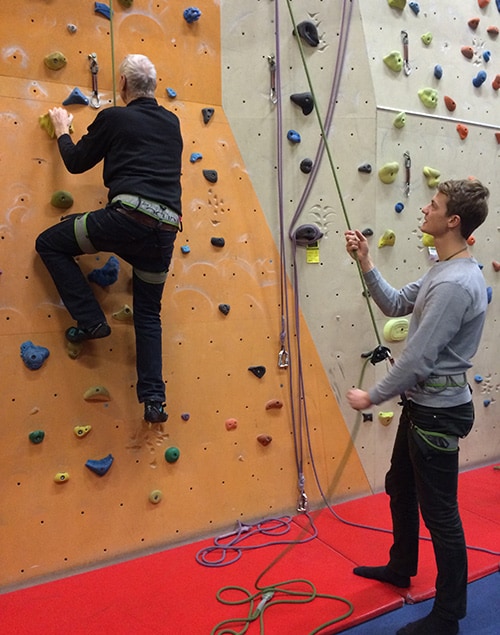Activity Climbing Tied to Improved Posture in Parkinson’s Ailment
Sport climbing can assistance make improvements to posture in individuals with Parkinson’s Condition (PD), such as more mature people, new research suggests.
In a randomized managed review, all those who participated in scaling a wall using ropes and mounted anchors had been less stooped at 12 months than a manage group that participated in some sort of unsupervised physical exercise.
Dr Heidemarie Zach
The benefits underscore that it is never as well late to discover a new sport or style of movement — and that this form of intervention may have major overall health payoffs, study investigator Heidemarie Zach, MD, associate professor of neurology, Professional medical College of Vienna, Austria, explained to Medscape Medical Information.
“There is no hurdle much too large over which you can’t climb, or load you won’t be able to conquer,” said Zach. “As very long as you can stroll independently and stroll up a stair, you can go climbing.”
The findings have been presented at the Worldwide Congress of Parkinson’s Disorder and Movement Disorders (MDS) 2022, held in Madrid, Spain and virtually.
Popular Attribute of PD
The investigation is portion of a larger job that included a review posted last yr demonstrating a lowered Unified Parkinson’s Disease Rating Scale Part III (UPDRS-III) score by practically 13 details in sufferers who participated in activity climbing. The activity was also appreciably related with enhanced bradykinesia, rigidity, and tremor.
The current examination targeted on stooped posture, which in addition to motor signs is a frequent attribute of PD. This postural deformity can consequence in significant distress, pain, and lowered good quality of existence.
Pharmaceutical solutions are primarily ineffective for postural deformities, scientists be aware. Actual physical treatment may perhaps assistance boost signs or symptoms, but only a couple of randomized experiments have examined improved posture in PD employing physiotherapy in standard and option sports activities in particular.
Sport climbing is “really exceptional” in PD, explained Zach, who has nonetheless to arrive throughout other exploration on this intervention. A climber herself, she proposed it to one particular of her individuals: a 79-yr aged male with PD who was a walker and hiker, and who finished up loving the activity. She named him her “pilot affected individual.”

“You can find no hurdle too high in excess of which you won’t be able to climb, or load you
are unable to conquer,” said review investigator Dr Heidemarie Zach.
The single-centre study included 48 adult contributors up to age 78 yrs (suggest age, about 65) with delicate to reasonable PD. Most were at Hoehn & Yahr stage 2, with some at stage 3. All had no earlier climbing working experience. Exclusion standards incorporated obtaining a ailment other than PD.
Scientists randomly assigned members to a activity climbing program or to a command group.
The activity climbing group had a 90-moment climbing session every single 7 days for 12 weeks in an indoor health club. Less than the supervision of an instructor, they were harnessed and related to ropes with mats placed on the ground for security.
The climbing wall was about 15 meters (50 ft) higher. Contributors typically began at 2 or 3 meters (6.5 to 9.5 ft) and labored their way up, Zach observed.
Those in the manage group were requested to take part for 12 weeks in unsupervised actual physical activity, as recommended by the World Health and fitness Organization and the European Physiotherapy Suggestions for Parkinson’s Sickness. This provided at least 2½ several hours minutes of reasonable-depth action or 75 minutes of vigorous action just about every 7 days.
Full-Entire body Exercise
The major outcome was enhancement in posture, measured utilizing a “simple” but extremely reputable device, said Zach. Although the sufferers stood with their again straight versus a wall, scientists calculated the distance in centimeters among the C7 sagittal vertical axis (C7SVA) and the wall.
The necessarily mean C7SVA at baseline did not considerably vary amongst the two teams, at 8.2 cm for the climbing team vs 7.7 cm for the management group.
Having said that, success showed only activity climbing was linked with drastically lessened ahead flexion of the cervical spine
The climbing team showed a lessen of the C7SVA by 1.7 cm (95% CI, .8 – 2.6 cm). “So climbers ended up far more erect and significantly less stooped after 12 weeks,” Zach stated.
She observed that the suggest variance in the handle team was .5 cm (95% CI, -.2 to 1.3 cm), which “is pretty much almost nothing.”
There did not look to be any predictor, such as age, sexual intercourse, or body mass index, for what affected person subgroups benefit the most from the intervention, Zach famous.
In outlining why climbing assists posture, she explained it is akin to “a complete-system exercise.”
The exercise improves upper-human body power by applying again and shoulder girdle muscle mass, as well as joint overall flexibility, Zach mentioned. Actions associated in climbing, these types of as recurring reaching for a distant maintain, stretch the muscle groups of the hip flexors and hip.
As these movements minimize rigidity, the climbing action may perhaps also advertise an upright posture. And as wall climbing consists of setting up and executing actions, it trains spatial entire body recognition, an critical part of keeping and correcting posture, she reported.
Zach noted a motivational team dynamic possible also contributed to the results of the intervention. “They were being cheering each and every other at the bottom” of the climbing wall, she reported.
The benefits exhibit that posture can be extra to the advancements in PD now documented from climbing, which includes improved motor signs, rigidity, and tremor, she claimed. The following move on the study agenda is to present no matter whether the intervention has a favourable impact on gait, Zach included.
“Really Adventurous”
Commenting on the research for Medscape Health care Information, Rebecca Gilbert, MD, PhD, main scientific officer at the American Parkinson Disease Association, reported she welcomes “any new notion” to help sufferers with PD — and that sport climbing seems “quite adventurous.”
“The general strategy that you are inquiring the system to transfer in a novel way is a great point for all people and specially for men and women with PD,” mentioned Gilbert, who was not involved with the research.
She observed that in PD, an suitable training intervention incorporates a mixture of 4 modalities: stretching, balance, aerobics, and strengthening. Rope climbing requires quite a few of these, in addition to a cognitive ingredient, Gilbert stated. It’s also vital that sufferers with PD participate in an action they enjoy, she added.
On the other hand, she pressured that security has to be “weighed,” specifically for clients with stage 3 PD, who typically have balance problems.
“It could be tough to climb a rope if you have harmony issues,” Gilbert stated. “The intervention wants to be personalized to the current incapacity, and most likely this action is a lot more a realistic factor for sufferers at milder phases.”
Zach and Gilbert have documented no appropriate economical associations.
Global Congress of Parkinson’s Disorder and Motion Issues (MDS) 2022. Summary 739. Presented September 16, 2022.
For far more information, abide by Medscape on Fb, Twitter, Instagram, YouTube, and LinkedIn
